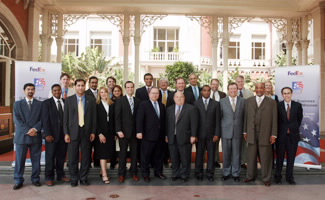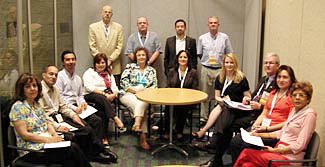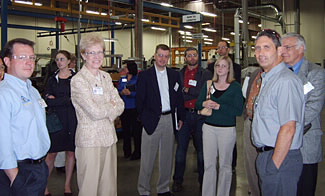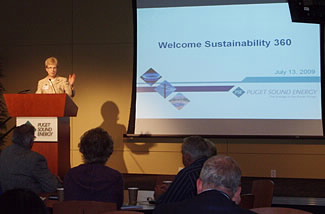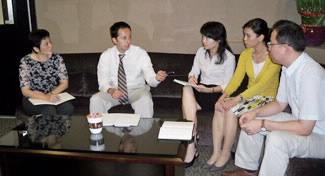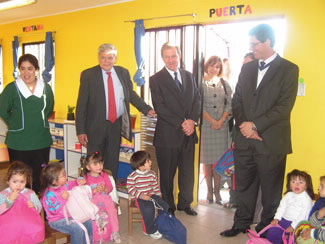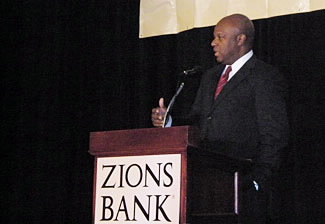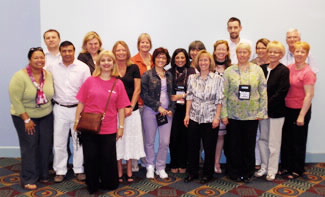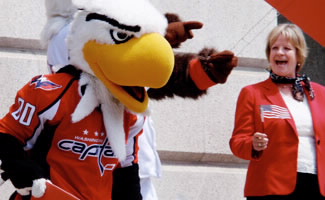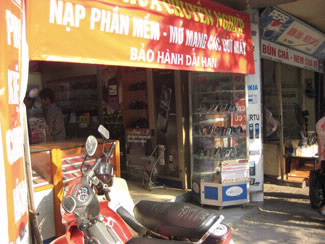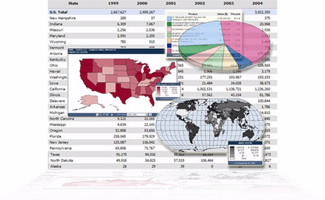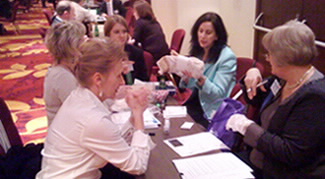
Tradeology, the ITA Blog
The Road to Copenhagen
Frank Caliva is an International Trade Specialist in the Office of Energy and Environmental Industries. He is also a former Presidential Management Fellow.
The international conversation regarding climate change, greenhouse gas emissions, energy usage, and environmental protection has taken on a heightened sense of priority lately. These issues are on the front page of our daily newspapers, the topics du jour among academics and policymakers, and the increasing focus of global conferences and summits. Our daily lives are starting to be impacted as well: more alternate-fueled cars on the road, more options for conserving energy and choosing the source of our electricity from our utility companies, and more ways for individuals to reduce our carbon footprints.
Making Progress
Some significant steps have also been taken by our national leaders. Legislation has been introduced in Congress to put a cap on carbon emissions, increase funding for renewable energy, and encourage more efficient practices by U.S. companies to reduce waste. Businesses are now more commonly implementing “green” strategies to lessen their impact on the environment. We are taking steps in the right direction, but real change will require a coordinated effort on a global level. To achieve this, we at ITA have been working with other federal agencies as participants in the United Nations Framework Convention on Climate Change (UNFCCC) negotiations. These discussions are focused on writing a new international agreement on climate change.
In 2007, countries decided to shape an ambitious and effective international response to climate change, to be formally agreed to in Copenhagen in December 2009. In the time since then, representatives from across the U.S. government have been talking with their foreign counterparts in preliminary meetings to lay the groundwork for the treaty. Only a few months away, all eyes are now looking ahead to the United Nations Climate Change Conference in Copenhagen this December.
Providing Input
Reducing greenhouse gas emissions is at the top of the conference agenda, but these negotiations will also touch on numerous other issues with significant implications for the U.S. business community—like intellectual property rights, research and development, technology sales, carbon financing, and energy efficiency. As an analyst at ITA, it is my job to ensure U.S. industries’ voices are heard during these critical negotiations, so that a solution is found that is not only effective but also recognizes the critical importance of innovation and entrepreneurship to a successful response to climate change.
To accomplish this goal, we have scheduled meetings across the United States leading up to the Copenhagen conference, where industry leaders will have the opportunity to meet with government representatives—from ITA and other federal agencies—to learn how this new proposed agreement could impact their businesses. These meetings will also help us prepare for the upcoming negotiations, by letting us hear the thoughts and concerns of the business community. The first of these meetings took place in Washington, DC at the Department of Commerce on July 16.
I hope to hear from many of you and would encourage your participation in upcoming events planned in Milwaukee on August 25, San Francisco on September 10, Pittsburgh on October 8, and Little Rock, with an additional option for firms nationwide to participate via webinar.
There are only a few months left before the Copenhagen conference. This is an important opportunity to lay out a plan on climate change which will reduce carbon emissions, enhance energy security, and protect our environment, while promoting development and economic growth.
Leave a reply or read comments
Commercial Service+ Corporate Partners = U.S. Exporter Success!
Greg Briscoe has been a Commercial Officer for eight years. He currently serves the U.S. and Foreign Commercial Service in Memphis, Tennessee and is responsible for managing cooperation under the Commercial Service-FedEx Corporate Partnership. Prior to coming to Memphis, Greg served in Tokyo, Japan and Paris, France.
I just completed another great phone call with a small U.S. company expanding its exporting profile as a direct result of cooperation between the U.S. Commercial Service and FedEx, a Commerce Service corporate partner. I’ve been following up with the 12 small- medium-sized FedEx clients that participated in the November 2008 FedEx Trade Mission to India that was certified by the Commercial Service. A few comments I’ve been hearing:
 | “You did in one week in India what it took me two years to do on my own in finding a suitable, trusted representative in India. This will increase our sales in India by three fold!” |
 | “The trade mission gave us the courage and perspective necessary to pursue the business success we are now experiencing in India, which will total 15% to 20% of our revenues over the next several years.” |
Needless to say, these have been very satisfying calls to take. But FedEx isn’t the only corporate partner working with us to help U.S. small- and medium-sized companies raise their export profiles.
|
Members of the FedEx Trade Mission to India Take Time to Pose for a Photo in Mumbai, India. (U.S. Department of Commerce photo) |
My colleagues and I also work with Baker & McKenzie, City National Bank, Comerica Bank, M&T Bank, PNC, TD Bank, the U.S. Postal Service, eBay, Google, UPS and Zions Bank to help increase U.S. exports. These are not the only private companies we work with, but this group of companies competed for a no-cost contract to become our promotional partners. They were awarded the contract to help promote the U.S. Commercial Service and increase the number of firms who export. In fact – we’re looking for additional partners now – look for it on fedbizopps.gov.
Together, by using webinars, seminars, and publications (such as “The Basic Guide to Exporting,” “Getting Paid by Your Latin American Buyer,” and “The Trade Finance Guide”) we educate companies on the “how to’s” of exporting. I think we are only scratching the surface of what we, the U.S. Commercial Service and our private sector partners, can do together. I look forward to many more calls with U.S. companies reporting on their successes overseas resulting from these very successful public/private partnerships. FedEx’s next trade mission is to Turkey this November. Join us!
Leave a reply or read comments
infoComm09, an IBP Event, has Its Biggest East Coast Show in History
Graylin Presbury has been with the International Trade Administration for 30 years. He has spent the last five years in the U.S. & Foreign Commercial Service (USFCS) as a Project Officer in the Global Trade Programs unit.
I had the privilege of being the project officer for InfoComm09, the world’s premier annual B2B conference and exposition for the professional audiovisual information communications industry. It alternates annually between the east and west coasts of the United States.
Both the weather and the technology were hot last month in Orlando at InfoComm09. The conference, held June 14-19, had more than 300 educational workshops and seminars, and the exhibition, held June 17-19, had roughly 850 exhibitors and more than 28,000 attendees, making this the biggest east cost show in its history.
|
ITA Global ICT Team in cooperation with the International Buyer Program at InfoComm09 (U.S. Department of Commerce photo) |
The International Business Center (IBC) provided a one-stop shop for U.S. Government assistance at the show. The IBC featured International Trade Administration (ITA) export and industry experts as well as representatives from the Export-Import Bank and the Small Business Administration.
As a project officer, I particularly appreciated having the support of ITA’s Global Information and Communications Technology (ICT) Team. Through the ICT Team and the USFCS International Buyer Program, we brought in nearly 500 delegates from 27 countries, including delegations from Argentina, Brazil, Columbia, Ecuador, Egypt, France, Mexico, Norway, the United Kingdom, and Uruguay. Additional ICT Team support came from trade staff in our U.S. Export Assistance Centers in Austin, TX; New York; Clearwater, FL; and Portland, OR, which included outreach and export counseling to exhibitors from their states and regions.
The ICT Team was instrumental to our success and the quality of services we delivered. Aside from the 20 or so U.S. exhibitors and attendees who visited the IBC, there were about 35 U.S. exhibitors that scheduled 130 appointments as part of the ICT Team’s Showtime program. In addition to the market counseling provided by USFCS overseas staff, ITA industry experts informed participants about market trends, trade policy and regulatory issues. Representatives from the Export-Import Bank and the Small Business Administration counseled exhibitors about loan guarantee programs, business development assistance and export credit insurance.
To read more about the International Buyer Program, please visit http://www.export.gov/IBP.
Leave a reply or read comments
Sustainable Manufacturing Tour
Acting U.S. Commerce Assistant Secretary for Manufacturing and Services Mary Saunders is leading a tour of four Seattle-area manufacturing facilities as part of the department’s Sustainability 360 initiative. The tour, Sustainability 360: An Aerospace Supply Chain Event, is designed to showcase the benefits of sustainable manufacturing throughout an aerospace manufacturing supply chain.
Sustainability 360
We just concluded our first Sustainability 360 event here in Seattle and the experience was outstanding – lots of good practical examples of how implementing sustainable manufacturing practices can reduce environmental impact and improve the bottom line for businesses. Sustainability 360 is what we are calling our regional tours of manufacturing facilities operating at various points in the supply chain, in this case the aerospace supply chain. Our sustainable manufacturing and aerospace teams in Manufacturing and Services worked with the U.S. Export Assistance Center and Washington Manufacturing Services, the Manufacturing Extension Partnership Center in the area, to put together a tour of four companies who are at various stages in their sustainability journey, to share their lessons learned and best practices with other local companies.
|
Participants visiting the new facility of Tyee Aircraft, a producer of aerospace components. Tyee has incorporated sustainable principles into its lean manufacturing practices with zero waste water release, energy efficient lighting, and recycling programs. (U.S. Department of Commerce photo.) |
We toured Puget Sound Energy, Tyee Aircraft, Goodrich Aerostructures and The Boeing Company, along with 24 local company representatives. And we learned a tremendous amount. For instances, successful companies are those that are “purpose driven”, with management and employees working toward a common goal. Sustainability takes into account the interest of the company itself in becoming more competitive; as well as the interests of investors, suppliers, customers and the community in which it operates. Ideas for improving sustainability can come from anyone in the company and even from suppliers and customers. There are no bad ideas. Sustainable Manufacturing practices save money and help grow business.
I have toured factory floors before, but I have never seen this much energy and enthusiasm, in companies ranging in size from a little more than a 100 employees to several thousand. Today’s program reinforced the practical value of the departments’ Sustainable Manufacturing Initiative and the value of public-private partnership in advancing the competitiveness of U. S. industry. What a hands on- way to spread the message to U.S. manufactures nationwide that sustainable manufacturing practices can deliver triple-win solutions that benefit U. S. firms, the communities in which they operate and the environment.
|
Mary Saunders giving her opening remarks for the Sustainability 360 event at utility Puget Sound Energy. PSE's 2008 energy efficiency work will result in annual savings for its customers of $30 million a year. (U.S. Department of Commerce photo.) |
Sustainable manufacturing is an area where the U.S. maintains a global competitive advantage. Not only are we the largest producer of clean technologies globally, we are also a leader in creating cutting edge, lean and clean manufacturing practices throughout industry supply chains. I am looking forward to our continued work in helping to spread the sustainable manufacturing message nationwide. For information on this initiative and its three components, take a look at http://www.manufacturing.gov/sustainability. Let us know what you think.
Leave a reply or read comments
Honoring a Man and his Legacy as a Presidential Management Fellow
David Kincaid is a first year Timothy J. Hauser Presidential Management Fellow who obtained his Masters degree from the George Washington University’s Elliott School of International Affairs. In addition to his coursework in international affairs and economics, David has experience in business and non-profit program management. During the first year of his PMF program, David has had the opportunity to work with Invest in America, the Corporate Partners Program, Advocacy Center, the Office of Energy and Environmental Industries, and is currently working with the Foreign-Trade Zones Board located in Import Administration.
Living up to expectations
Last August, when I joined ITA, I arrived on the scene bearing, in addition to the title Presidential Management Fellow or PMF, the name of a man I had never known—Timothy J. Hauser. Many told his story, each expression unique, yet the message was the same—Tim had been a pillar of the ITA family and had left an indelible mark on the soul of this organization. But for me, one piece of his story resonated with clarity. As someone close to Hauser said, “Tim advocated that all ITA personnel should seek a variety of experiences in the organization. Only in this way can they see how it all works together and get beyond the weeds.” I took Timothy Hauser’s inspiration to heart and embarked on my journey as a PMF.
During my Masters program I learned a great deal about the work of ITA, I learned about trade law, antidumping and countervailing duties, I learned there are four business units within ITA and that Census and BEA are not part of ITA but rather are part of Commerce, I even learned that certain offices conduct trade policy analysis and others support the efforts of the U.S. Trade Representative. But who knew there are USEACs and political appointees and taskers and that hundreds of people work to foster exports of everything from chemicals to cars and from tourism to pension funds? There was no course on TMs and IBPs, FSNs and SCOs, or how OSP works on PIPs for MAS, CS, MAC, ODUS, OCFO, and IA through WBTs developed by folks in OCIO! It’s true; the alphabet soup was at best daunting to learn. But, beyond the intellectualist brain-tickling, far more valuable lessons have come of my PMF journey.
Working through others to achieve a common goal
On the first day of my new position, a respected voice said to me, “the greatest skill you can learn here at Commerce is working through others to achieve a common goal.” And oi!, how true it is—even beyond the walls of this building—because this is, in fact, what we do here. The International Trade Administration is made up of thousands of people who work tirelessly through others to achieve a goal on behalf of the American people. They work to ensure opportunities for small and medium-sized businesses overseas, they work to create jobs for Americans, they work to level the playing field in the global marketplace for U.S. companies, they work to foster innovative and cutting-edge strategies for American competitiveness, they work to serve the American people. Whether it be promoting foreign direct investments that create job opportunities for American workers, or engaging corporate partners who may facilitate U.S. exports, or advocating on behalf of American companies for foreign contracts, or opening foreign markets for civil nuclear reactor builders, utilities and wastewater technology industries, or programs that reduce duties on value added imports so American manufacturers can remain competitive and keep jobs at home. I have worked in all these areas and have met people working through others to serve the American people.
And so it is that I am now armed with many rewarding experiences, a renewed understanding of people and the inspiration of Timothy Hauser. Having now gained a 30,000 foot view of the organization and having built an abundance of rewarding relationships, I am grateful for the opportunity to participate as a PMF and honored to be of service as part of the ITA family.
Leave a reply or read comments
A Day in the Life of a First-Tour CS Officer
Ricardo Pelaez is a first-tour Commercial Officer serving with the U.S. and Foreign Commercial Service in Taipei. He and his team of three Commercial Specialists covers a broad spectrum of industry sectors including consumer goods, education, architecture/construction/engineering, environmental technologies, and power generation. Before joining CS Taipei in August 2008, Ricardo served as a Senior International Trade Specialist in the U.S. and Foreign Commercial Service’s Cleveland, OH and Akron, OH U.S. Export Assistance Centers for over 10 years.
Greetings from Taipei!
Today was a really busy day for me here, but I’m excited and satisfied with the day’s results. Following a typical morning of meeting with each member of my team and checking emails, I attended a fellow officer’s going away lunch. After lunch I was headed for a public diplomacy speaking engagement at YuDa High School. This school has been selected to act as the host sponsor of the U.S. Deaflympic Team. Taipei will host the 2009 Deaflympics, an official event of the International Olympic Committee, this September. This school of 5,500 Taiwan students will cheer on over 300 athletes and coaches representing the United States and over 5,000 athletes and coaches representing 81 countries. As part of the school’s preparations, they invited me to come and speak to them about “U.S. Culture and Values.”
|
Commercial Service Taipei Team Meeting. Department of Commerce photo |
The most exciting part of the day was the final event on my schedule. After several months of planning, long hours, and hard work, CS Taipei finally kicked off the first of three “America Month” retail events promoting several hundred U.S. brands to Taiwan consumers. In recent years, CS Taipei has organized several America Month events with local retail partners, but this year we were looking to hit a homerun. CS Taipei partnered with three of Taiwan’s largest retailers, including Miramar Entertainment Park and Shin Kong Mitsukoshi Department Store in Taipei, and Dream Mall down in Kaohsiung.
We, and the American Institute in Taiwan’s (AIT) Agricultural Trade Office, have been collaborating with our retail partners to invite every single U.S. brand and franchise in their retail outlets to participate in this fantastic opportunity. We also helped each of our partners recruit special vendors, identify and invite entertainment performers, create a media exposure plan, and do whatever else we can do within our capacity to ensure the success of the America Month.
June 24 was the official opening of the America Month event at Miramar, a shopping mall that also boasts a Ferris wheel, a movie theater and an IMAX. Miramar’s theme is “American Beauty and Strength,” reflecting the American lifestyle, its free spirit, and multifaceted culture.
During the America Month, over 100 American brands at Miramar, including apparel, cosmetics, food and wine, and restaurants, are offering special activities and discounts to create a joyful and entertaining shopping experience. Miramar’s two-week long event will culminate on the Fourth of July. They have planned several activities to celebrate the 233rd anniversary of the U.S. Independence Day, including, a cheerleading performance, Hawaiian hula dance performance, and a grand finale 233-second fireworks display.
Mitsukoshi and Dream Mall have also launched their America Month campaigns as well. Mitsukoshi, for instance, is featuring a theme on U.S. Route 66. We have been helping them define the elements necessary to illustrate the Route 66 spirit. It is really exciting to see our months of work finally coming to fruition.
Leave a reply or read comments
Paris Air Show
Daniel Harris is Senior Commercial Officer, U.S. and Foreign Commercial Service at the U.S. Embassy, Paris.
If you enjoy the thrill of a heart-stopping experience, you should have been with me at the Paris Air Show this past week. The jet fighter screamed past the spectators, then stood on its tail and then shot straight up, engines roaring as if it were a rocket rather than an airplane. After gaining altitude, the fighter rolled over on its back in a long arc until the plane pointed straight down, accelerating rapidly towards the earth. As my heart rate started rising, the pilot pulled the fighter onto a smooth, level course in front of the crowd, which included six United States Senators and a host of other dignitaries from around the world.
Welcome to the Paris Air Show!
A highlight for me was the opening of the U.S. Pavilion, where I had the honor to introduce several distinguished Americans, especially Senator Daniel Inouye of Hawaii, the President’s Representative to the Paris Air Show, holder of the Congressional Medal of Honor and a much respected figure in and out of the U.S. Senate. Other speakers included the Secretary of the U.S. Air Force, Michael Donley and the U.S. Chargé d’Affairs, Mark Pekala.
Commercial Service Paris also escorted the members of the U.S. Congressional delegation from the Senate Appropriations Committee to their meetings at show. The delegation was led by its Chairman, Senator Inouye, accompanied by Senator Thad Cochran (Mississippi), Senator Tom Harkin (Iowa), Senator Richard Shelby (Alabama), Senator Byron Dorgan (North Dakota) and Senator Jim Inhofe (Oklahoma). The final highlight of the day was the opening night gala Aerospace Industries Association (AIA) reception for 1100 American exhibitors and guests at the residence of the U.S. Ambassador.
The Paris Air Show, Europe’s largest aerospace exhibition, takes place every two years at the Le Bourget exposition site and airport. Over 300 U.S. exhibitors, including 162 companies and American states exhibited inside the U.S. Pavilion (organized by Kallman Worldwide) – the largest national delegation at the show. The Commerce Department’s acting Assistant Secretary for Manufacturing and Services, Mary Saunders, was also on site to meet with her counterparts from governments around the world who send representatives to this huge biennial event.
The activity was non-stop as business deals were discussed in the corporate “chalets” that line the flight line at the airfield, while enjoying great views of the flight demos. The CS team at the U.S. Commercial Service Paris (CS Paris) office within the U.S. Embassy Paris, together with the Office of Defense Cooperation (ODC), jointly support the commercial and military aspects of the show, with assistance from several other U.S. government agencies, including the FAA and NASA.
Leave a reply or read comments
Waste Expo Highlights the Latest Waste Management and Recycling Technologies
Vidya Kori has been with the International Trade Administration for 5 years. She currently serves as a Project Officer in the United States and Foreign Commercial Service’s International Buyer Program.
I am writing from the bustling International Business Center located at Waste Expo 2009, North America’s largest trade show serving the solid waste and recycling industries. Here in Las Vegas Nevada, over 500 exhibitors are showcasing the latest equipment and technologies the industry has to offer. There are also 40 conference sessions and training workshops led by industry experts on current topics such as Green Management and Technology, Recycling, Energy, and Landfill Operations. The International Trade Administration’s (ITA) own Marc Lemmond (a trade specialist from ITA’s Office of Energy and Environmental Industries, a part of the Manufacturing and Services unit) was one of the speakers at a seminar titled E-Waste: New Laws, New Programs. Although this seminar took place on the pre-exhibition day, well over 100 people were in attendance at this seminar, even with 3 other concurrent sessions going on! Marc enlightened the audience on the international drivers for electronics recycling. The seminar focused on the fact that discarded electronics should be considered a recyclable commodity, not waste - for this reason, the recycling community prefers the term “e-scrap” to e-waste. The falling cost of electronics, transition to digital TV, and new technologies such as LED are making discarded electronics the fastest growing segment of the municipal waste stream. U.S. and international regulations are reinforcing market opportunities for shredding, sorting, and treatment technologies for electronics recycling. The session was very popular and well-received!
As a participant in the International Buyer Program (IBP), Waste Expo was promoted by United States and Foreign Commercial Service (USFCS) around the world resulting in USFCS Specialists recruiting and leading buyer delegations here to meet U.S. exhibitors from Vietnam, Romania, Japan, Ukraine, Saudi Arabia, Dominican Republic, Kenya, Nigeria, Ghana and Cameroon. It’s been great to see so many international buyer delegates meeting with U.S. companies here in the International Business Center! The show also features a U.S. Export Pavilion with representatives from within the Department of Commerce (Census and Commercial Service) and Export Import Bank. "I've been to several trade shows over the past few years and there seems to be a higher percentage of U.S. manufactured goods and services in this industry than in the other shows," stated Kelly Kemp from Export Import Bank.
It is only the first day of the 2.5 half day exhibition and so many important introductions and meetings have taken place. I’m excited to see what the next two days have to offer and commend all the Commerce and government representatives at the show for all their hard work on making this show a great success! For other shows participating in the IBP, you should check out www.export.gov/IBP.
Leave a reply or read comments
Be Brief, Be Bright, Be Gone
Walter Bastian is Deputy Assistant Secretary of Commerce for the Western Hemisphere, a part of Market Access and Compliance.
From June 1 to June 5, I had the opportunity to lead a group of U.S. business executives on a trade mission to Santiago, Chile and Lima, Peru. The mission was comprised of executives pursuing business opportunities across a wide range of manufacturing and service sectors. The results were impressive.
Chile and Peru were selected as target markets for a variety of reasons, including market potential and ease of doing business. These factors were enhanced by the existence of free trade agreements each has with the United States. Besides the eventual elimination of all tariffs on U.S. products entering these markets, these agreements establish clear and transparent rules for the conduct of business with U.S. firms. These agreements have worked. In the case of Chile, U.S. exports in 2008 were up 49.4 percent over the year before and in Peru, U.S. exports were up 51 percent over the same period. U.S. exports to Chile are up 345 percent since 2004 when the agreement went into effect. Last year, Peru was the fastest growing export market in the Western Hemisphere.
|
Daycare center funded by U.S. companies and United Way Chile. (Department of Commerce photo) |
The heart of the mission is the business matchmaking service provided by the U.S. and Foreign Commercial Service in both countries. Each company had appointments each day with prescreened local companies. The mission participants also had the opportunity to meet and talk to members of the U.S. and local business communities at events hosted by the embassies. The days were full. Meals became business meetings. The business days lasted well into the night.
Chris Hood of Coastal International Logistics, LLC, noted that his business philosophy was to “be brief, be bright, be gone.” He had a contract before leaving the first stop. He and the other mission members seemed to adhere to the same philosophy and contributed to a highly successful trade mission.
While mission members were busy developing new clients and pursuing commercial opportunities, I met with government officials to pursue issues which would further enhance the competitiveness of U.S. firms in these markets. I met with customs officials, economy and energy ministers, business groups and NGOs. I also visited examples of U.S. corporate social responsibility and highlighted the value of partnerships with the U.S. private sector.
The mission was truly representative of a public/private sector partnership. In the end, the public and private sectors accomplished their mutual objectives of contributing to the economic growth of the United States and creating U.S. jobs through exports.
Leave a reply or read comments
Globalization in the Midst of Recession- Prominent Business and Government Officials Headline Utah's World Trade Week Conference
Posted: June 4, 2009 (This post was written on May 20, 2009.)
Dave Fiscus is the Director of the U.S. Foreign & Commercial Service's Utah Export Assistance Center, where he helps Utah companies compete and succeed in the international marketplace. He's been with the International Trade Administration for ten years.
Greetings from Salt Lake City, home of the 2002 Winter Olympics and one of the fastest growing export markets in the country! I'm here at Zions Bank's 8th Annual International Trade and Business Conference. Zions Bank, a corporate partner of the U.S. Foreign & Commercial Service (CS), has assembled a great cast of speakers to address this year's topic, "Globalization in the Midst of Recession." Zions Bank's President and CEO, Scott Anderson, just provided opening remarks, in which the Zions Bank-CS partnership featured prominently (a great highlight for the CS and for the corporate partnership program!).
Over 800 members of Utah's business community turned out for this half day event of presentations from officials representing all sectors of the economy from government to manufacturing to academia.
Rick Wade, Senior Advisor and Deputy Chief of Staff for the Department of Commerce just concluded his kick-off remarks. They were spot on with the theme of the conference and very well received by attendees. He pointed out that Secretary of Commerce Gary Locke said in his confirmation hearing that he is committed to "work every day to make the Commerce Department an engine for improving our competitiveness, encouraging innovation, and creating jobs." Furthermore, he stated that partnerships are a critical component of this goal, and the Secretary and our team intend to strengthen our relationships with business, other federal agencies, and state and local organizations to position the United States as a global leader in exports and innovation.
|
Rick Wade, Deputy Chief of Staff, Department of Commerce, speaks at the Zions Bank's 8th Annual International Trade and Business Conference in Salt Lake City, Utah on May 20, 2009. (U.S. Department of Commerce photo) |
The audience also just heard that last year, exports accounted for 13 percent of U.S. economic growth and supported millions of jobs in the United States. The U.S. exported an astounding $1.84 trillion worth of goods and services. To put this in historical context, exports accounted for nearly 10 percent of our gross domestic product five years earlier and 5 percent 40 years ago.
Governor Jon M. Huntsman, Jr., who was recently appointed as the next U.S. Ambassador to China by President Obama, just stopped by to accept Utah's "Internationalist of the Year Award". The Governor provided remarks, underscoring the theme of the day. A fitting send-off for a leader who made Utah's global competitiveness a hallmark of his tenure at the helm of the state.
Well, we're going into a break and my colleague Jeff Hamilton and I need to head over to the Commercial Service Utah table in the exhibitor information section of the conference alongside Trade Promotion Coordinating Committee partners Ex-Im Bank and SBA as well as various local trade multipliers. Russell Roberts, Professor of Economics at George Mason University and Tom Donohue, President and CEO of the U.S. Chamber of Commerce are slated to round out the day's agenda.
Best from the American West!
Leave a reply or read comments
Pow Wow Kicks Off in Miami
Posted: June 2, 2009 (This post was written on May 20, 2009)
Helen Marano is the Director of the Office of Travel and Tourism Industries which serves as the National Tourism Office for the United States. She has worked in the travel and tourism industry for 18 years.
I am writing you from Pow Wow in sunny Miami. Pow Wow is the travel and tourism industry’s premier international sales and marketing event. It’s great to be here with a strong federal presence from the Departments of State and Homeland Security, as well as our Travel & Tourism Team from the U.S. Commercial Service. Part of our mission at Pow Wow is to educate international travel leaders about new entry and exit programs and provide the latest information about U.S. travel destinations programs, and inbound visitation statistics.
|
International Trade Administration Travel and Tourism Team. U.S. Department of Commerce photo. |
It’s exciting to see over 4,000 attendees here from all over the world. They’re folks from State Tourism offices, cities, attractions, hotels, travel journalists and foreign buyers of U.S. travel and tourism products and services. It is great to see commerce at work with more than 50,000 appointments between buyers and sellers taking place this week. These negotiations typically generate over $3 billion in future travel to the United States.
Today, Commerce Secretary Gary Locke spoke at Pow Wow’s closing luncheon. He said, “I am especially pleased to note that travel and tourism is responsible for over one-fourth of all services exports for the United States. And for the 20th consecutive year, travel and tourism produced a travel trade surplus for the U.S. – a record $29.7 billion.” He went on to say, “What is impossible to count are the friendships that were formed, the perspectives that were broadened, or the discoveries that were made about a new culture and country as a result of traveling to the United States.”
Events like Pow Wow are an excellent opportunity for individual destinations like Miami to showcase their attractions and venues to international buyers. Pow Wow shows how resilient the travel and tourism industry is and what an engine it is for economic growth. Events such as Pow Wow help generate more visitors to the U.S., more dollars spent, and more jobs created.
Leave a reply or read comments
World Trade Week Begins
Jeremy Caplan is a public affairs specialist in the International Trade Administration’s Office of Public Affairs.
On May 6, 2009, President Barak Obama issued a presidential proclamation that May 17-May 23, 2009, be observed as World Trade Week and encouraged “all Americans to observe this week with events, trade shows, and educational programs that celebrate the benefits of trade to our Nation and the global economy.”
Since international trade is what we’re all about here at the International Trade Administration, it probably won’t surprise anyone that we look forward to World Trade Week every year and are involved quite a few events and other goings on this week and throughout the month. We are planning to have new World Trade Week related content on the ITA Blog each day this week, so please check in every day this week to see what’s new. Thanks and see you soon!
Leave a reply or read comments
U.S. Travel and Tourism: The Little Engine that Could
Sean Timmins is an International Trade Specialist on the Trade Missions Team in the U.S. & Foreign Commercial Service. He is currently on rotation in the Office of Travel and Tourism Industries which serves as the National Tourism Office for the United States.
I am writing you today from the steps of the Smithsonian Institution’s National Portrait Gallery in downtown Washington, D.C. where members of Congress and tourism leaders from the public and private sector are participating in the first ever U.S. Travel Rally Day. We are partnering with Destination DC (the local convention and visitors bureau) and the U.S. Travel Association to celebrate the importance of the travel and tourism industry to the United States’ economy. Similar rallies are taking place in 36 cities across the country, from Seattle to Orlando and Albuquerque to Cincinnati.
|
Helen Marano (right), Director, Office of Travel and Tourism Industries, with Washington Capitals mascot "Slapshot" on the steps of the National Portrait Gallery while participating in U.S. Travel Rally Day. (U.S. Department of Commerce photograph.) |
Did you know that the U.S. travel and tourism industry accounts for 2.6% of total U.S. GDP? Over 8 million American jobs are supported by the travel and tourism industry and almost a million of those jobs are supported by international travelers coming to the U.S. It’s important to remember that travel and tourism not only creates and supports jobs in hotels, airlines, and car rental companies, but also in restaurants, movie theaters, bars, malls, gas stations, coffee shops, amusement parks and just about anywhere else that provides a service. In 2008, a record 58 million international visitors came to the United States. The largest number came from Canada, followed by Mexico, the United Kingdom, Japan and Germany.
My boss, Helen Marano (Director, Office of Travel and Tourism Industries), said “Travel is the ultimate freedom. Peoples from every nation can get away from their daily lives to experience new destinations, ‘walk in different shoes,’ meet people from different cultures, and learn to appreciate both their differences and their similarities.” She went on to say, “Travel builds bridges between peoples and cultures. Travel builds understanding between peoples and cultures. Travel builds diplomacy.”
May is a big month for U.S. travel and tourism. Next week, the travel and tourism industry’s premier international sales and marketing event, Pow Wow, will take place in Miami. More than 4,200 attendees have registered, including more than 1,600 international travel buyers and nearly 400 journalists from over 70 countries. Helen will be blogging from Miami, so check back next week to hear what she’s got to say about this event!
So get out there and do your part – become a traveler. You can start by logging onto www.DiscoverAmerica.com, a promotional website that was developed through a cooperative agreement between the United States Department of Commerce and the U.S. Travel Association.
Leave a reply or read comments
DOC and DOT Connected to Address Supply Chain Issues
Bruce Harsh is responsible for Commerce’s Distribution and Supply Chain unit and has been with the Department about 24 years.
America's economy depends on the health of our country's supply chain infrastructure. Problems with the supply chain are not readily noticeable until you don’t get the part you need to keep your supply chain in operation, or the gift you were looking for at a store during the holiday season. Not only do supply chain problems make America’s producers and consumers mad, they are clearly linked to our economic recovery and long-term economic growth.
Supply chains don't just move products and goods, they also support jobs. One recent report by the U.S. Chamber of Commerce suggests that approximately 110 million U.S. jobs or nearly 80 percent of the entire workforce is critically dependent on our supply chain and transportation infrastructure.
This past Monday, leading supply chain stakeholders met in Washington, DC at the joint Department of Commerce-Department of Transportation conference titled, “Game Changers in the Supply Chain Infrastructure: Are We Ready to Play?” to hold a frank discussion with decision-makers on how to deal with current problems that minimize their ability get those products and services to consumers in a timely, safe, and environmentally-friendly manner and to develop a world-class network to reduce the chance of “game changers” thwarting these goals in the future.
The discussion stirred up lots of suggestions and comments. Panelists and audience participants emphasized that restoring America’s manufacturing jobs depends on not just fixing one part of the supply chain infrastructure but to look at these issues from the start at the manufacturer’s factory floor , or field, to the consumer’s house or company facility. They encouraged governmental agencies to come together to develop a holistic, comprehensive national freight policy that promotes the supply chains and assures America’s competitive advantage in the 21st century.
These suggestions were heard and many participants appreciated seeing two secretaries, Secretary of Commerce Gary Locke and Secretary of Transportation Ray LaHood, stand together to say they were going to have their agencies work together to meet these goals. Many participants also appreciated hearing leading experts share how they would minimize those “game changers” that produce constraints and chokepoints, and offer ways for the government to encourage innovative information technologies, improve security and resilience, and do all of this in an environmentally sound manner to restore America’s world-class transportation network.
Leave a reply or read comments
Vietnam's Emerging Telecom Market Creates New Trade Opportunities
Senior International Trade Specialist Cora Dickson joined the U.S. Department of Commerce’s International Trade Administration in 2001. She helped to establish the U.S.-Vietnam Information and Communications Technologies (ICT) Dialogue, an interagency initiative led by ITA.
Last month on my second visit to Vietnam, it was evident that U.S. companies are taking a keen interest in Vietnam’s telecom market. As an analyst I can tell you several objective reasons why Vietnam holds such potential, but seeing it firsthand makes me a believer.
|
A cellular phone store in Hanoi, Vietnam. (Dept. of Commerce photo) |
In the downtown streets of Hanoi and Ho Chi Minh City, cell phones are becoming as ubiquitous as the scooters, bicycles, and rickshaws. You might even see farmers in straw hats carrying their goods the old-fashioned way, balanced on a pole over their shoulders, but they have cell phones too.
Some Vietnamese citizens even have more than one cell phone, confounding those who try to keep accurate statistics on mobile subscribers in Vietnam. Furthermore, a major upgrade is about to happen in Vietnam now that the government has issued several spectrum licenses for “third generation” (3G) digital wireless services. The manufacturers of handsets and other equipment have been salivating for years at the potential 3G opportunities as they watched Vietnam’s market take off.
Of course it’s not all about mobile. Internet Service Providers (ISPs) are another growing business in Vietnam, and many of the ISPs are private enterprises formed within the past ten years. Most of the broadband services are concentrated in the two major urban areas but the government is actively promoting policies for build out to the rural provinces. Meanwhile, reliable telecom infrastructure is absolutely essential to attract more foreign investment and multinational corporations (MNCs) to Vietnam. Some U.S. telecom companies already serve the MNCs globally and they would like to add Vietnam branches to their networks.
While Vietnam’s telecom market is rapidly modernizing, the telecom regulatory framework still reflects the pre-WTO accession mindset. However, new rules are taking shape through draft legislation that will bring Vietnam’s laws in line with its WTO commitments. I’ve been hearing from U.S. companies who have been eagerly awaiting this legislation, which could really make it easier to do business in Vietnam. Thus, I worked with the Commercial Service post in Hanoi and Vietnam’s Ministry of Information and Communications (MIC) to organize a half-day seminar on April 18th focusing on Vietnam’s draft telecom law.
The U.S. companies left the seminar with the impression that MIC had been willing to listen to their input and will continue to engage with the private sector as they refine the text of the bill, which is expected to be adopted by Vietnam’s National Assembly by the end of the year.
I left Hanoi feeling satisfied as a catalyst for a robust exchange of views between the U.S. companies and the Vietnamese government.
Leave a reply or read comments
How Commercial Service Helps Exporters
Patrick McRae is a Foreign Service Officer with the U.S. & Foreign Commercial Service. He is currently assigned to the Grand Rapids,Michigan Export Assistance Center.
My colleagues and I assist Michigan-based firms access and develop foreign markets. Truth be told though, many small or medium-sized firms were quite reluctant to consider international sales, especially when things were going so well domestically…
Economic downturn, however, has greatly enhanced our business community’s interest in international markets. In fact, I just had a conversation with a potential new-to-export firm that went something like this:
Me: “So, you have a good product here…you really should think about selling overseas.”
Potential Exporter: “Sell internationally? Don’t you have to be a major player to go international? I really need to increase sales! How do we go about it?”
At which point I assured him that almost any product is exportable, regardless of the size of the firm, and the Commercial Service can help make it happen!
Another counseling session successfully underway….
I went on to explain that the export process usually begins with an assessment of a firm’s “export readiness” where an international trade specialist sits down with the client to review the firm’s readiness to explore and implement export related activities.
Next comes the market research phase, where we identify “best prospect” markets. Commercial Service trade specialists carry out basic research, using an extensive array of trade data bases compiled and maintained by the ITA. These services are typically offered free of charge. Once basic research indicates potential export markets, our clients may choose to pursue specialized market research in order to gain more detailed market insight such as competitive presence, pricing, nature of relevant supply chains, etc. These services are typically provided for a small fee.
With this enhanced understanding of the target market, a client may wish to meet with key in-country contacts such as potential distributors, sales agents, strategic allies or joint venture partners. Through our Gold Key Service, we will identify, screen, select and set up meetings so that in a matter of days, clients may begin to forge the relationships that will be critical to future export success!
At this point, having gone through the pre-export research and planning process, you will design and implement a well thought-out international business plan and begin the cycle of planning-implementation-assessment-adjustment.
I wrapped up the conversation with an assurance that trade professionals throughout the ITA will be there to assist in the transition from export-novice to export-expert!
Leave a reply or read comments
The Greatest Shows on Earth
Doug Barry is a trade specialist with the Trade Information Center. You can talk to him and his colleagues by calling 1-800-USA-TRADE.
Trade shows are one of the best ways to generate international sales, and some of the world’s largest are found in Germany. Why there? Two reasons: Germans have been organizing shows since the Middle Ages, and Germany is a relatively easy flight for business folks from elsewhere on the continent, the Middle East, Africa and the United States.
So, Germany plays host to all kinds of industry shows including pet products, books, musical instruments, medical equipment, IT and more. Americans go there to meet buyers from everywhere—without having to spend a small fortune flying everywhere.
Filling the Order Books
I recently attended CeBIT, the world’s largest IT show held each year in Hannover. I went to make a video on what U.S. companies need to know to make sales there, beyond having a good product. What I found at CeBIT were many small U.S. companies, which were filling their order books for the next year by engaging in best practices including trolling the show website for prospects before arrival; signage tricks to attract traffic; ploys for generating industry press; and book-length strategies for finding and scoring points at parties that start at 5pm everyday with German precision.
Horns of a Dilemma
Now, with world trade in the doldrums, you might reasonably ask, “Why bother?” One answer is that trade is showing signs of life—U.S. exports were up 1.6 percent in February and are likely to return to their record pace. Second, the chance to get in front of eager buyers from countries your frequent flyer miles won’t reach is too good to ignore. Third, the International Trade Administration, through the U.S. Commercial Service, can help you before, during and after the show—generating prospects, finding low cost space, tutoring on business culture and protocol.
Last point: see for yourself. Here are five videos covering the show; what the Commercial Service can do for you; best practices for making sales; protecting your intellectual property; and mixing business with pleasure.
Been to or want to go to an international trade show? Share your best practices and ask your questions in this space.
Leave a reply or read comments
Trade Stats Express: Using the Tools the Pros Use to Find New Export Markets
Slade Broom has been with the International Trade Administration for five years. He currently serves as the Senior Advisor to the Deputy Assistant Secretary for Industry Analysis.
As an analyst with the International Trade Administration (ITA), the data that I use in my analysis of international trade has to be timely and accurate. Dependable data helps ITA’s analysts and economists develop strategies and recommendations that lead directly to sound economic policies. Better still, you can use this data to analyze trade flows and foreign markets that can make your business more competitive.
My office, the Office of Industry Analysis, serves as ITA’s gateway to economic data. The tools that I use every day to analyze trade flows and industry output aren’t just limited to government use: they’re available for your business as well! Best of all, they’re easy to use and they’re available 24 hours a day, free of charge.
One of the tools I use daily is Trade Stats Express (TSE). In less time than it takes you to brew a cup of coffee, you can use TSE to learn that in 2008 alone:
 | The U.S. exported over $1.3 trillion worth of merchandise to the international community. |
 | Of those exports, more than $1.1 trillion were manufactured goods. |
 | Total goods exports from the U.S. grew by 11.8% over 2007. |
|
Trade Stats Express offers tools to retrieve, visualize, analyze, download and print export, import and trade balance data at the national and state level, as well as by industry. |
You may be asking “How does that help me better understand my industry and potential markets for trade?” The answer is in TSE’s entire suite of tools. TSE provides micro-level trade data that can show you trade patterns for a specific product (i.e. Harmonized System Codes), a specific industry (i.e. NAICS codes), from a specific state (e.g. Texas), and to a specific market (e.g. New Zealand). This information can provide you with tools for you to determine new markets where your products can be viable. You can even sort your results by dollar amount, dollar change, and percent change over prior year.
For example, by employing the State Export Data function on TSE, a furniture manufacturer (NAICS 337) in Michigan could determine that, in 2008:
 | The international market represented more than $4.5 billion in total exports of U.S. furniture and related products, and U.S. sales internationally expanded by almost $549 million since 2007. |
 | Canada and Mexico were the largest importers of furniture from Michigan, but Saudi Arabia (118% growth), Mexico (113% growth), Qatar (28%) and the United Arab Emirates (21%) showcased rapid growth within the top 10 foreign markets for Michigan’s furniture. Overall, Michigan’s furniture exports grew by almost 17%, an increase of nearly $72.6 million. |
 | Michigan’s furniture exports account for nearly $503 million of the $40 billion in exports of manufactured goods. |
Tools like TSE provide an additional source of information for American businesses to use in examining and targeting foreign markets for new sales. And the best part is that this is one of many tools that ITA has to offer. Check out ITA’s Industry Trade Data and Analysis website to see what additional tools and reports can assist you!
Leave a reply or read comments
World IP Day
Andrea Cornwell is an International Trade Specialist with the Office of Intellectual Property Rights in the International Trade Administration’s Market Access & Compliance unit.
Intellectual property surrounds us almost constantly. And it’s not just McDonald’s trademark Golden Arches or Apple’s patented iPod technology or Miley Cyrus’ latest copyrighted album. For instance, I would bet that you create content protected by copyright nearly every day. Have you written an email today? Have you doodled on your notebook during a meeting or class this week? Have you snapped a family photo recently? If so, then you’re an author – an author with a copyrighted work.
The fact that intellectual property rights (IPR) exist in so many facets of our daily lives just goes to show that our Founding Fathers were right – provide people with legal protection for their inventions and creative works, and technology will advance, knowledge will spread, and societies will progress. Did you know that our Constitution authorizes Congress to protect inventors’ and authors’ creative works? Or, that our current trademark law preserves a long American heritage of 120-plus years of protection for our entrepreneurs’ trade names, logos, and the like?
In fact, IPR is so essential to continued global development and trade that each year we celebrate World Intellectual Property Day on April 26th. This year, World IP Day focuses on Green Innovation and the important role of IPR in promoting the advancement and diffusion of increasingly critical technologies for the mitigation of climate change. This coincides nicely with widespread celebration of Earth Day on April 22nd, and provides us with an opportunity to proudly say that, as global environmental needs evolve, our American entrepreneurs are developing new means for addressing them. According to the House Small Business Committee, the renewable and efficiency industries, comprised of more than 90% small firms, created 8 million new jobs in 2006. The U.S. Conference of Mayors estimates that by 2038, the American green tech industry’s development could add another 4.2 million jobs to the economy.
So, you see, the fundamental IPR principle established so many years ago still rings true today – IPR protection is essential to encouraging innovation and competitiveness. This is particularly relevant to the growing green tech industry, as both U.S. industry and our global community stand to see great benefits from new technologies and methods for addressing climate change. As Francis Gurry, Director General of the UN’s World Intellectual Property Organization, recently said, “The power of human ingenuity is our best hope for restoring the delicate balance between ourselves and our environment.” This World IP Day, the International Trade Administration welcomes the celebration of Green Innovation and our green technology industry.
For more information on IPR and ITA’s activities related to IPR, please visit StopFakes.gov.
Leave a reply or read comments
80 U.S. Companies Test the European Market in Poland
Rochelle J. Lipsitz is the Acting Assistant Secretary for Trade Promotion and the Director General of the U. S. and Foreign Commercial Service.
I am writing to you live from Warsaw, Poland, here with 80 U.S. companies at our third Annual Trade Winds Forum.
Did you know this year is the U.S.’s 90th year of diplomatic relations with Poland? It’s amazing to consider how far Poland has come since the years of Woodrow Wilson. Today, Poland’s economy is one of the best performers in Europe and, despite the global economic crisis, it is still growing at about 1% per annum, while many countries are still struggling. In addition to having a stable government and about $15 billion of U.S. investment, it serves as an anchor market for U.S. companies trying to sell to Central and Eastern Europe – which is why the U.S. Commercial Service and our clients are here.
|
Acting Assistant Secretary for Trade Promotion and Director General of the U.S. and Foreign Commercial Service Rochelle J. Lipsitz (left) with representatives from U.S. company Taking the Waters, a spa treatment company, at the Trade Winds Forum in Warsaw, Poland. (U.S. Department of Commerce Photo) |
Eighty U.S. companies have joined us to participate in more than 800 individual meetings with our Senior Commercial Officers from 28 U.S. Embassies across Europe who are giving them an individual assessment of sales opportunities in countries from Portugal to Kazakhstan. During the three meetings I have been able to observe so far, clients and Officers discussed market potential and how to find business partners. They compared notes on trade shows and discussed logistics. And, a lot of discussion focused on how to get paid – especially in our current credit crunch. Throughout these back-to-back, 20-minute counseling sessions – which looked a lot like speed dating – the company representatives were able to learn how their products would fare in various countries and the steps they should take to successfully enter the market. The room was just buzzing with energy! The goal is that the U.S. companies will walk away from these two days with a strategy for selling throughout Europe.
We don’t only want them to take home a strategy though, but business too. So we’ve also arranged nearly 400 meetings for the U.S. companies with Polish buyers and potential partners. Nearly 40% of the companies attending the Trade Winds Forum are repeat attendees who were at last year’s program in Istanbul, Turkey. Firms from that event reported dozens of export sales as a result of their meetings, and we look forward to the same great results this year.
When the event is done, the U.S. Commercial Service will have arranged nearly 1,200 meetings for these U.S. companies to help them increase their international sales! Why do we do this, you ask? Because increasing international sales stimulates our economy by creating higher-paying jobs at home.
I look forward to writing again about how the U.S. Commercial Service is helping U.S. companies sell overseas…. Maybe next time you’ll be here too!
Leave a reply or read comments
We Have Launched a Blog
Jeremy Caplan is a public affairs specialist in the International Trade Administration’s Office of Public Affairs.
Yes, government blogs are a hot topic in some quarters these days. In the public and within the government itself, there is a healthy mix of excitement and [insert a negative word of your choice] about what they might be able to help accomplish and how smooth or bumpy the road to get there may be. At the International Trade Administration, we think that the blog format could be a great way for us to engage citizens, businesses, and our other stakeholders in a new way (for us as an organization, at least) in a discussion about what we do and why do it, so we decided to launch a blog.
The ITA Blog is to be a study of international trade and the issues involved between us at ITA and you, the trade-interested community. It is meant to be an ongoing dialogue about how trade benefits U.S. businesses and what ITA is doing to helping them achieve those benefits. The ITA Blog will be a new channel to provide context for trade promotion, policy and analysis to show how trade fits into the bigger picture. It will answer questions about what is trade and why is it important?
The ITA Blog will feature blog posts written by ITA employees at all levels. From our trade specialists working directly with companies to help them achieve their first exports to our analysts working in Washington cubicles to our senior officials, we will show you what ITA is doing on trade.
What comes next after the blog entries are posted is up to you. We will provide you an opportunity to reply to our blog posts and we look forward to engaging you in discussions about the questions and issues they raise. So, please, join us as we take up the study of international trade.
A note on blog functionality: As we begin our international trade adventure with you here on the ITA Blog, you may notice the absence of some normal blog features (RSS feeds, categories, etc). We know that they are needed and will add them as soon as we can. Those of you that have worked with the government before probably know that simple is never as simple as it should be. We know that here, too.
Leave a reply or read comments
The ITA blog Tradeology is not affiliated with http://tradeologyusa.com/. This link is provided as reference only and does not reflect an endorsement of the goods or services of Tradeology USA.
- The Road to Copenhagen
- Commercial Service + Corporate Partners = U.S. Exporter Success!
- infoComm09, an IBP Event, has Its Biggest East Coast Show in History
- Sustainable Manufacturing Tour
- Honoring a Man and his Legacy as a Presidential Management Fellow
- A Day in the Life of a First-Tour CS Officer
- Paris Air Show
- Waste Expo Highlights the Latest Waste Management and Recycling Technologies
- Be Brief, Be Bright, Be Gone
- Globalization in the Midst of Recession
- Pow Wow Kicks Off in Miami
- World Trade Week Begins
- U.S. Travel and Tourism: The Little Engine that Could
- DOC and DOT Connected to Address Supply Chain Issues
- Vietnam's Emerging Telecom Market Creates New Trade Opportunities
- How Commercial Service Helps Exporters
- The Greatest Shows on Earth
- Trade Stats Express: Using the Tools the Pros Use
- World IP Day
- 80 US Companies Test the European Market in Poland
- We Have Launched a Blog
